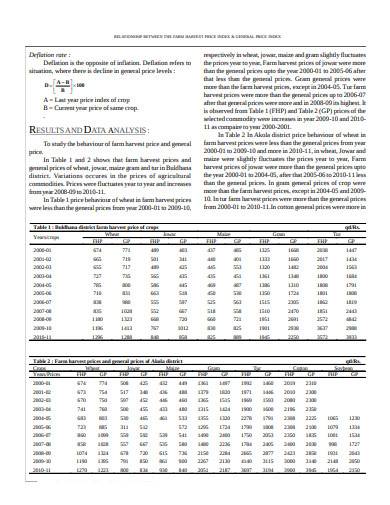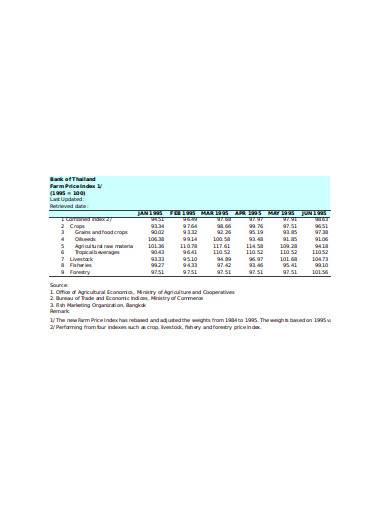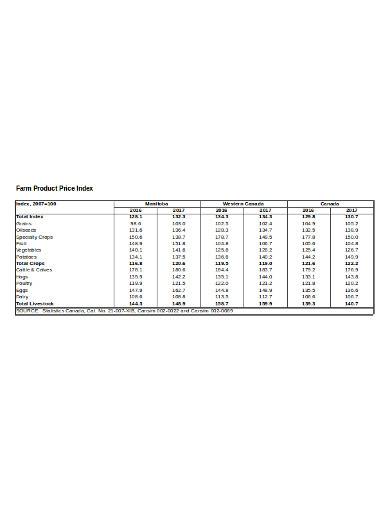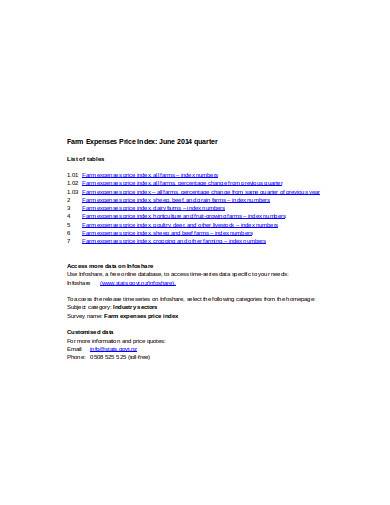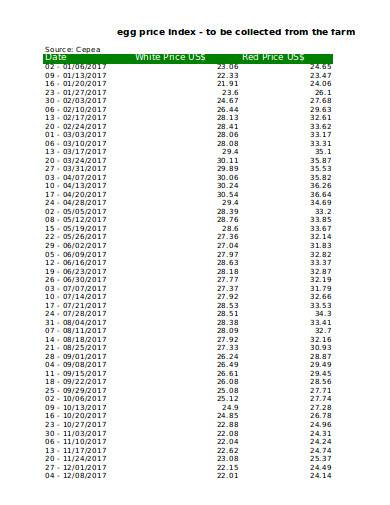Whether you are a producer of cotton, crops, eggs, chicken, dairy products, or any agricultural commodity, using particular tools or information systems, such as a farm price index, can be essential to optimize the profit you earn. If you are here to gather more information about this essential tool, you are in the right place. We also included a set of examples, which you can use as a reference if you are working on a project that involves using one, such as developing a farm business plan.
What is a Farm Price Index
A farm price index is a report that the U.S. Department of Agriculture’s National Agricultural Statistics Service (NASS) releases every month. This report consists of the prices of the agricultural products, which you can use as a reference in setting a price for your agricultural products.
Additionally, the data that the farm price index contains is a crucial economic indicator, making it this type of report a vital tool for economists. Through this report, they can determine the direction of economic movement by observing the rising and falling of produces prices overtime.
Farmers Pricing Strategies
If you want your farm to produce more profit, you have to think like a businessman. Use the following strategy to increase your sales volume and expand your market.
1. Bulk Pricing
If you have a high amount of products that need to get sold in a limited period, you may try using bulk pricing. Through this pricing strategy, you can make more sales since it compels the customers to buy in bulk due to the thought that says buying in high volume with a discount they can save more money compared to buying in lesser quantity.
2. Bundle Pricing
By bundling products that produce lower sales with another product that sells, you can ensure that all of your products will get sold out instead of wasting some of it. For example, you are selling carrots and other vegetables. However, it happens that your carrots are generating lower sales than your expectations. To ensure that you still make sales with the carrots, you can chop them along with other vegetables and create a mix of vegetables to sell.
3. Good, Better, Best Pricing
Some agricultural commodities can be too expensive for some potential buyers to purchase. However, by implementing this pricing method, you can give them an option to buy the other products instead. You can base the pricing of these products on the products’ demand level and characteristics. You can also use the previous sales reports of your products to determine which products sell better than the other, making it a helpful tool to categorize your products effectively.
4. Penetration Pricing
The goal of this pricing strategy is to build a long-term relationship with the customer by eliminating the uncertainty that the customers perceived, which prevents them from buying your products. In this strategy, you will introduce your products with a discounted or lower price for a limited time. If your customers become satisfied with your products, they will buy your products with confidence by the time you change the price to its regular price.
5. Loss Leader Pricing
Another way to increase your sales is to set selected items to lower prices. Through this pricing method, you can attract more customers to your store. However, when using this strategy, you have to make sure that your other products can make up for the loss of particular products.
5+ Farm Price Index Samples
Are you looking for a farm price index examples for your project? Go over the following zipped documents. You can download these files in Adobe PDF and M.S. Excel formats for free!
1. Farm Harvest Price Index Sample
2. Farm Price Index Template
3. Farm Product Price Index Sample
4. Farm Expenses Price Index Template
5. Producer’s Price Indicies for Farm Products Sample
6. Egg Price Index in Excel
Pricing of Agricultural Products Using the Farm Price Index
A farm price index is a great tool that allows you to determine the right price of your agricultural commodities. In this section, we will discuss how to apply this tool in your pricing strategy.
1. Calculate the Production Cost
Calculate all the costs related to the production of your final products, from seeding to harvesting. You will use this calculation to determine the retail price of the goods. You can also use a budget template to account for all the production costs properly.
2. Identify Your Customers
By understanding your customers, you can have a strong basis for determining the proper price that can ensure that your commodities get sold. You can also conduct a target market analysis to gather more information about your customers.
3. Monitor Market Trends
Another thing you can do to make your basis in determining the price of your products is to monitor the market trends. First, you will check for the latest farm price index report that the authorities published. This tool will allow you to know the average sales price that people in the industry apply. You can also try using other tools, such as consumer price index, producer price index, and the wholesale price index for a broader pricing coverage.
4. Set Your Price Range
Once you identify the production cost, your market, and the trends, it will be easier for you to decide the right price of your products. Take your time to analyze the data that you have, and determine the right price for your products.
5. Lower Your Production Cost
To get more flexibility in price setting, you can attempt to find ways to lower your production cost. You can conduct research or ask your colleagues which stores offer production supplies at a lower cost. You can also join a co-op or any agricultural organizations that allow their members to avail their machinery and equipment at more affordable prices or to get access to more affordable land.
Tools, such as a farm price index, plays a vital role not just in the agricultural industry, but also in the global economy. In this article, we have discussed how to utilize this tool properly. However, you should know that this tool will work better if you incorporate it into a more significant part of your business, which is the farm business plan development.
Related Posts
Weekly Schedule Samples & Templates
Contractual Agreement Samples & Templates
FREE 9+ Amazing Sample Church Bulletin Templates in PSD | PDF
Sample Business Card Templates
Sample Cashier Job Descriptions
Questionnaire Samples
FREE 10+ Sample HR Resource Templates in PDF
FREE 10+ HR Consulting Business Plan Samples in MS Word | Google Docs | Pages | PDF
FREE 49+ Sample Job Descriptions in PDF | MS Word
FREE 16+ Nonprofit Budget Samples in PDF | MS Word | Excel | Google Docs | Google Sheets | Numbers | Pages
FREE 13+ Academic Calendar Templates in Google Docs | MS Word | Pages | PDF
FREE 10+ How to Create an Executive Summary Samples in Google Docs | MS Word | Pages | PDF
FREE 23+ Sample Event Calendar Templates in PDF | MS Word | Google Docs | Apple Pages
Company Profile Samples
FREE 10+ Leadership Report Samples [ Development, Training, Camp ]

